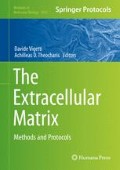Abstract
The average molecular mass of hyaluronan (HA) in most healthy biological fluids and tissues is usually about 6000–8000 kDa, but the biosynthetic mechanism results in a polydisperse mixture of sizes. Subsequent enzymatic degradation, or the action of reactive oxygen and nitrogen species, can further increase polydispersity and decrease the average size. Fragmented HA can be a biomarker of inflammation. In addition, reductions in HA size are associated with tissue remodeling and repair processes. Some cell-surface receptor proteins have been reported to have HA-binding affinities that are size specific, and participate in activation of signaling cascades controlling multiple aspects of cell behavior. Here we describe simple agarose gel electrophoresis protocols for the determination of the molecular mass distribution of HA isolated from tissues and fluids.
Access this chapter
Tax calculation will be finalised at checkout
Purchases are for personal use only
References
Knudson W, Gundlach MW, Schmid TM, Conrad HE (1984) Selective hydrolysis of chondroitin sulfates by hyaluronidase. Biochemistry 23(2):368–375
Hampson IN, Gallagher JT (1984) Separation of radiolabelled glycosaminoglycan oligosaccharides by polyacrylamide-gel electrophoresis. Biochem J 221(3):697–705
Cowman MK, Slahetka MF, Hittner DM, Kim J, Forino M, Gadelrab G (1984) Polyacrylamide-gel electrophoresis and Alcian Blue staining of sulphated glycosaminoglycan oligosaccharides. Biochem J 221(3):707–716
Min H, Cowman MK (1986) Combined Alcian blue and silver staining of glycosaminoglycans in polyacrylamide gels: application to electrophoretic analysis of molecular weight distribution. Anal Biochem 155(2):275–285
Lee HG, Cowman MK (1994) An agarose gel electrophoretic method for analysis of hyaluronan molecular weight distribution. Anal Biochem 219(2):278–287
Bhilocha S, Amin R, Pandya M, Yuan H, Tank M, LoBello J, Shytuhina A, Wang W, Wisniewski HG, de la Motte C, Cowman MK (2011) Agarose and polyacrylamide gel electrophoresis methods for molecular mass analysis of 5- to 500-kDa hyaluronan. Anal Biochem 417(1):41–49
Cowman MK, Chen CC, Pandya M, Yuan H, Ramkishun D, LoBello J, Bhilocha S, Russell-Puleri S, Skendaj E, Mijovic J, Jing W (2011) Improved agarose gel electrophoresis method and molecular mass calculation for high molecular mass hyaluronan. Anal Biochem 417(1):50–56
Ikegami-Kawai M, Takahashi T (2002) Microanalysis of hyaluronan oligosaccharides by polyacrylamide gel electrophoresis and its application to assay of hyaluronidase activity. Anal Biochem 311(2):157–165
Cowman MK (2017) Hyaluronan and hyaluronan fragments. Adv Carbohydr Chem Biochem 74:1–59
Jing W, DeAngelis PL (2004) Synchronized chemoenzymatic synthesis of monodisperse hyaluronan polymers. J Biol Chem 279(40):42345–42349
Jing W, Haller FM, Almond A, DeAngelis PL (2006) Defined megadalton hyaluronan polymer standards. Anal Biochem 355(2):183–188
Armstrong SE, Bell DR (2002) Measurement of high-molecular-weight hyaluronan in solid tissue using agarose gel electrophoresis. Anal Biochem 308(2):255–264
Takeo S, Fujise M, Akiyama T, Habuchi H, Itano N, Matsuo T, Aigaki T, Kimata K, Nakato H (2004) In vivo hyaluronan synthesis upon expression of the mammalian hyaluronan synthase gene in Drosophila. J Biol Chem 279(18):18920–18925
Yuan H, Tank M, Alsofyani A, Shah N, Talati N, LoBello JC, Kim JR, Oonuki Y, de la Motte CA, Cowman MK (2013) Molecular mass dependence of hyaluronan detection by sandwich ELISA-like assay and membrane blotting using biotinylated hyaluronan binding protein. Glycobiology 23(11):1270–1280
Tolg C, Hamilton SR, Zalinska E, McCulloch L, Amin R, Akentieva N, Winnik F, Savani R, Bagli DJ, Luyt LG, Cowman MK, McCarthy JB, Turley EA (2012) A RHAMM mimetic peptide blocks hyaluronan signaling and reduces inflammation and fibrogenesis in excisional skin wounds. Am J Pathol 181(4):1250–1270
Yuan H, Amin R, Ye X, de la Motte CA, Cowman MK (2015) Determination of hyaluronan molecular mass distribution in human breast milk. Anal Biochem 474:78–88
Tolg C, Yuan H, Flynn SM, Basu K, Ma J, Tse KCK, Kowalska B, Vulkanesku D, Cowman MK, McCarthy JB, Turley EA (2017) Hyaluronan modulates growth factor induced mammary gland branching in a size dependent manner. Matrix Biol 63:117–132
Yingsung W, Zhuo L, Morgelin M, Yoneda M, Kida D, Watanabe H, Ishiguro N, Iwata H, Kimata K (2003) Molecular heterogeneity of the SHAP-hyaluronan complex. Isolation and characterization of the complex in synovial fluid from patients with rheumatoid arthritis. J Biol Chem 278(35):32710–32718
He H, Li W, Tseng DY, Zhang S, Chen SY, Day AJ, Tseng SC (2009) Biochemical characterization and function of complexes formed by hyaluronan and the heavy chains of inter-alpha-inhibitor (HC*HA) purified from extracts of human amniotic membrane. J Biol Chem 284(30):20136–20146
Author information
Authors and Affiliations
Corresponding author
Editor information
Editors and Affiliations
Rights and permissions
Copyright information
© 2019 Springer Science+Business Media, LLC, part of Springer Nature
About this protocol
Cite this protocol
Cowman, M.K. (2019). Methods for Hyaluronan Molecular Mass Determination by Agarose Gel Electrophoresis. In: Vigetti, D., Theocharis, A.D. (eds) The Extracellular Matrix. Methods in Molecular Biology, vol 1952. Humana Press, New York, NY. https://doi.org/10.1007/978-1-4939-9133-4_8
Download citation
DOI: https://doi.org/10.1007/978-1-4939-9133-4_8
Publisher Name: Humana Press, New York, NY
Print ISBN: 978-1-4939-9132-7
Online ISBN: 978-1-4939-9133-4
eBook Packages: Springer Protocols

